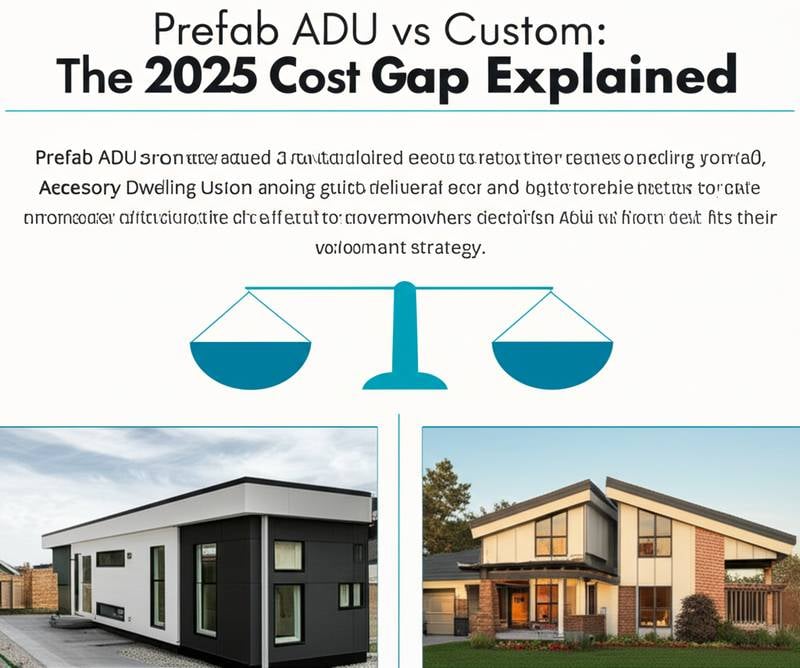2025 Prefab ADUs: Achieve 25-35% Savings Over Site-Built Alternatives
Accessory dwelling units, or ADUs, offer homeowners versatile solutions for additional living space, income generation, or family accommodations. In 2025, prefabricated ADUs emerge as a cost-effective choice, delivering 25 to 35 percent savings compared to traditional site-built constructions. This article explores the key cost differences, influencing factors, and strategies to maximize value in your ADU project.
Understanding Prefab and Site-Built ADUs
Prefab ADUs consist of modules manufactured in a controlled factory environment and assembled on-site, which streamlines the building process. Site-built ADUs, in contrast, involve constructing the entire structure from the ground up at the location, often leading to extended timelines and higher expenses. The choice between these approaches depends on your budget, timeline, and site constraints.
Factory production for prefab units minimizes weather-related delays and optimizes material use, contributing to overall efficiency. Site-built projects, while customizable, expose builders to on-site variables that can inflate costs. Homeowners benefit from prefab options when seeking quicker occupancy without sacrificing quality.
Cost Breakdown: Prefab Versus Site-Built in 2025
Average costs for a 600-square-foot prefab ADU in 2025 range from $120,000 to $180,000, including delivery and basic installation. Site-built equivalents typically cost $160,000 to $250,000 for the same size, reflecting higher labor and material handling expenses. These figures account for standard finishes and compliance with building codes.
Prefab savings stem from reduced labor hours, as modules arrive nearly complete, requiring only foundation work and utility connections. Site-built ADUs demand full on-site framing, roofing, and interior work, which accumulate expenses through extended crew presence. Regional variations, such as labor rates in urban areas, can widen this gap further.
Hidden costs in site-built projects often include permits delayed by inspections and material price fluctuations due to supply chain issues. Prefab ADUs mitigate these through pre-approved designs and bulk purchasing by manufacturers. Budget planners should allocate 10 to 15 percent extra for unforeseen site preparations in either case.
Key Factors Influencing ADU Pricing
Size represents the primary driver of costs, with each additional square foot adding $200 to $300 for prefab and $250 to $400 for site-built units. Standard models under 500 square feet qualify for streamlined permitting in many jurisdictions, lowering administrative fees. Larger custom designs escalate prices due to increased material and engineering needs.
Finishes and features significantly impact the total. Basic prefab ADUs with vinyl flooring and standard appliances start at the lower end, while upgrades to hardwood or energy-efficient systems add 15 to 20 percent. Site-built options allow greater customization from the outset, but modifications mid-project can double those costs.
Labor and site conditions play crucial roles. Prefab installation requires skilled crews for only one to two weeks, compared to two to four months for site-built. Challenging sites, such as sloped terrain or limited access, increase expenses by 20 percent or more, particularly for on-site construction.
Timelines and Efficiency Advantages
Prefab ADUs achieve completion in 4 to 8 weeks from order to occupancy, assuming prompt permitting. Site-built projects extend to 3 to 6 months, influenced by weather and subcontractor availability. Shorter timelines reduce financing costs and enable faster revenue from rentals.
Efficiency in prefab construction also enhances sustainability, with less waste and lower energy use during production. Site-built methods, while adaptable, generate more on-site debris and require extensive quality checks. These differences appeal to environmentally conscious homeowners seeking long-term savings.
Return on Investment Potential
ADUs boost property value by 10 to 20 percent, with prefab models offering quicker ROI through rental income. A 600-square-foot unit might generate $1,500 monthly rent, recouping costs in 7 to 10 years for prefab versus 9 to 12 for site-built. Location factors, like proximity to urban centers, amplify these returns.
Tax incentives and zoning changes in 2025 further enhance viability, especially for prefab units that meet green building standards. Homeowners calculate ROI by subtracting ongoing maintenance from income streams. Prefab durability, backed by warranties, minimizes repair expenses over time.
Strategies to Maximize Savings
- Select standardized prefab designs to avoid custom fees and expedite approvals.
- Conduct a thorough site assessment early to identify preparation needs and budget accordingly.
- Compare multiple prefab manufacturers for competitive pricing and included features.
- Integrate energy-efficient elements, such as solar panels, to qualify for rebates and reduce utility bills.
- Plan utility connections during the design phase to prevent costly retrofits.
These steps ensure your ADU project stays within budget while delivering lasting value. Consult local regulations to leverage available incentives.
Planning Your ADU Project for Success
Begin with a clear vision of your ADU's purpose, whether for aging parents, guests, or rental use. Gather quotes from certified prefab providers and site builders to compare apples-to-apples estimates. Secure financing options tailored to modular construction for optimal terms.
Engage professionals for permitting and inspections to navigate 2025 code updates seamlessly. Track progress with detailed timelines to maintain momentum. Your well-planned ADU will enhance your property and lifestyle for years ahead.










